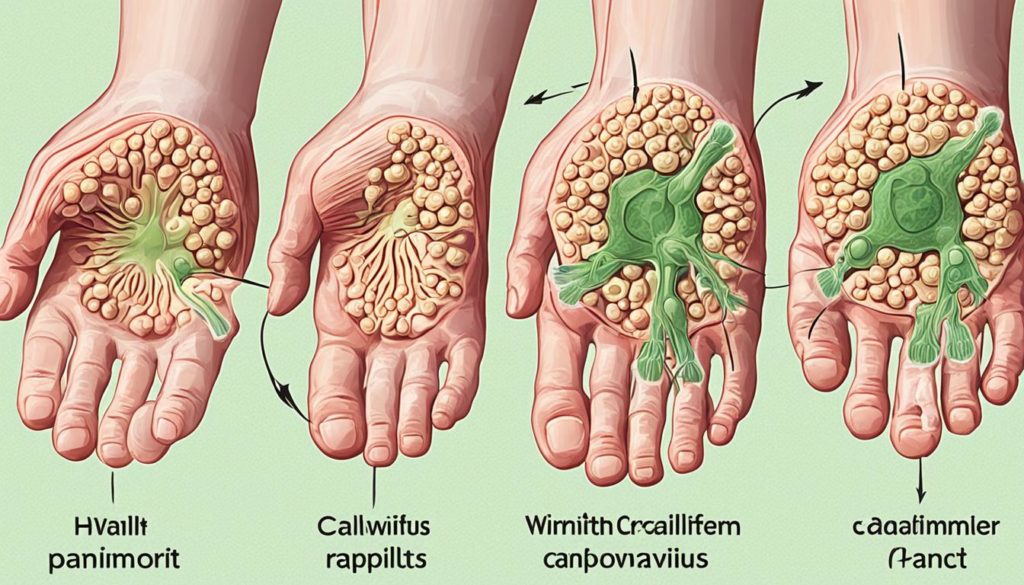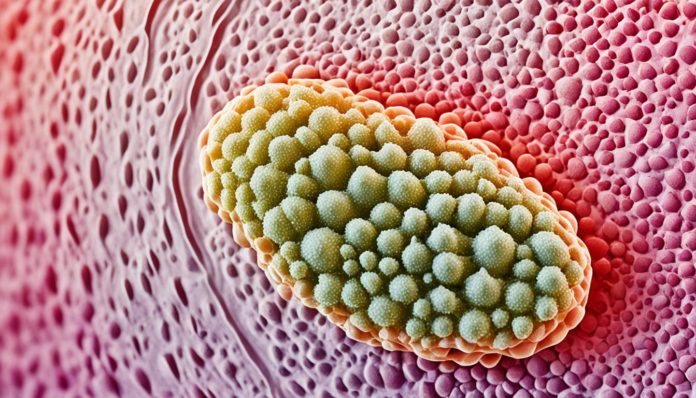About 10% of people will get warts in their lifetime. These small skin growths can really affect one’s day-to-day life. This is especially true for warts on the feet and hands. Knowing what causes plantar warts and palmar warts can help. It also helps to know how to treat them. This can make life better by improving foot and hand health.
Key Takeaways
- Plantar warts and palmar warts affect approximately 10% of the population.
- Understanding these skin conditions is crucial for maintaining optimal skin health, including foot health and hand functionality.
- Effective treatment options are available for both plantar warts and palmar warts.
- Preventative measures can reduce the risk of developing warts on your feet and hands.
- Knowledge of risk factors and symptoms aids in early detection and management.
Introduction to Plantar Warts and Palmar Warts
Plantar and palmar warts are common and caused by the Human Papillomavirus (HPV). Knowing about them helps manage them better.
Understanding Skin Warts
Warts are benign skin growths from HPV. They appear after the virus gets in through small skin cuts, causing warts. HPV types linked to warts affect the feet (plantar) and hands (palmar).

Plantar warts show up on the feet’s soles, often making walking painful. Palmar warts form on the hands and can disrupt daily tasks. Both types are generally benign but can be unsightly and uncomfortable.
Epidemiology of Warts
Warts are more common in kids and young adults. This could be due to more injuries and closer physical contact. Warts on feet spread in damp places like showers. Warts on hands come from direct contact.
In the US, 7-10% of people get warts. The rates are higher in schools and gyms. Some are more prone due to genes or immune differences. However, clean habits and protection cut down HPV risks.
What are Plantar Warts?
Plantar warts are non-cancerous skin bumps on the feet’s bottom, caused by HPV infection. They’re known for their unique look and where they show up.
Characteristics of Plantar Warts
These warts look like small, rough, and grainy spots. They might have black dots, which are clotted blood vessels. They can be alone or grouped as mosaic warts. Walking or standing can hurt because they are on parts of the foot that bear weight.

Common Locations on Feet
Plantar warts usually appear on the heel or ball of the foot. These areas get a lot of pressure, pushing the warts under a callus. Knowing where they pop up helps in quick identification. This makes treating them easier and more effective.
What are Palmar Warts?
Palmar warts show up on the hands and are caused by the human papillomavirus (HPV). It’s important to identify them correctly. This helps tell them apart from other types of hand growths. Knowing their characteristics and usual spots helps in identifying Palmar Warts effectively.
Characteristics of Palmar Warts
Palmar warts are raised bumps with a rough surface, often looking like cauliflower. They might be alone or in groups. Sometimes, you can see tiny black dots inside, which are clotted blood vessels. These signs help identify Palmar Warts and tell them from other skin issues.
Common Locations on Hands
Palmar warts usually pop up on palms and fingers, sometimes around nails too. They can make everyday tasks harder. The causes include touching contaminated surfaces and having cuts on the skin.
| Location | Description | Symptoms |
|---|---|---|
| Palms | Often rough and raised | May cause discomfort |
| Fingers | Usually in clusters | Interferes with hand function |
| Around Nails | Flat or raised | Painful if pressure applied |
Recognizing the signs of Palmar Warts is key for early prevention and treatment. Keeping hands clean also helps prevent their causes and manages existing warts.
Causes of Plantar Warts
Plantar warts appear as small bumps on the feet. They result from a viral infection. Understanding what causes them and their risk factors can prevent these skin issues.
HPV Infection
The main Causes of Plantar Warts come from the Human Papillomavirus (HPV). This virus enters the skin through small cuts or breaks. It then causes warts to develop. There are specific HPV strains responsible for plantar warts. These strains thrive in warm, moist places. Thus, plantar warts often spread in places like pools, locker rooms, and shower areas.
Risk Factors
Some factors make people more likely to get warts. These include walking barefoot in communal areas and having a weak immune system. Direct contact with someone who has warts can also be a risk. Kids and teens often get more cuts on their feet, making them more prone to warts. Also, if someone has very sweaty feet, it creates a perfect environment for the virus.
Environmental Triggers
Where you are can also affect your risk of getting warts. Wet places shared with others, like showers or pool areas, are risky. The virus can survive on these surfaces for a while. So, it’s important to stay hygienic and use flip-flops in these areas. This can help keep the virus away.
Knowing the main Causes of Plantar Warts helps avoid them. Pay attention to HPV infection, risk factors, and environmental triggers. This way, you can defend yourself against these contagious bumps.
Causes of Palmar Warts
Palmar warts appear on the hands, mainly due to the human papillomavirus (HPV). Small cuts or abrasions let this virus enter the skin, causing warts. Knowing what causes palmar warts can help stop them from spreading and manage them better.
HPV Infection
Different HPV strains cause various warts, with some leading to palmar warts on the hands. These warts aren’t just unsightly; they can also be uncomfortable. HPV thrives in places where lots of people gather, making it easier for warts to spread.
Risk Factors
Several things increase the chance of getting palmar warts:
- Direct Contact: Touching warts on someone or something that has warts ups your risk.
- Immune System Health: If your immune system isn’t strong, you’re more likely to get HPV and warts on your hands.
- Frequent Skin Breaks: Cuts or abrasions on your hands make it easier for HPV to get in.
To lower the risk of getting HPV on your hands, keep them clean and avoid touching warts directly.
| Risk Factor | Impact |
|---|---|
| Direct Contact | Increased risk of Palmar Warts Transmission |
| Immune System Health | Higher susceptibility to HPV and hand wart risks |
| Frequent Skin Breaks | Greater likelihood of HPV infection |
Symptoms of Plantar Warts
Knowing the symptoms of plantar warts helps in identifying and treating them properly. These warts have unique features that set them apart from look-alikes like corns or calluses.
Visible Signs
One main sign of plantar warts is a rough, grainy growth on the foot’s sole. It usually shows up on parts of the foot that bear weight, like the heel. They can have a tiny black dot, caused by a clotted blood vessel, making the wart look ‘seeded’.
Pain and Discomfort
The visible signs are easy to spot, but the pain they cause is hard to ignore. People often feel sharp pain from the warts when they stand or walk. This pain may make them change how they stand or walk. This is to lessen the pressure on the wart, yet it might lead to more problems. The pain is a clear sign that sets plantar warts apart from the painless corns or calluses.
Symptoms of Palmar Warts
Palmar warts, also known as verrucae vulgaris, show symptoms that affect hand use. Spotting these symptoms early helps with effective care.
Visible Signs
The main visible signs are small, grainy bumps, mostly on the hands. They might be flesh-colored with a rough feel. For wart identification on hands, look for tiny black dots. These are clotted blood vessels on the wart. Spotting them helps tell warts from other skin issues, making hand wart symptoms easier to identify.
Impact on Hand Function
Palmar warts disrupt hand tasks. The discomfort from palmar warts makes holding or touching things painful. Pain gets worse with repeated use or pressure, causing ongoing annoyance. Palmar warts discomfort also hinders work and fun activities, pushing people to get medical help.
If you notice unusual growths or changes on your hands, act quickly. Early help can boost comfort and hand use, stopping further problems.
| Symptom | Description | Impact |
|---|---|---|
| Small Grainy Growths | Rough-textured, flesh-colored lumps, often with black dots | Affects appearance, can be painful, especially under pressure |
| Discomfort During Tasks | Pain and irritation when gripping or handling objects | Reduces efficiency in daily activities, impacts professional and recreational tasks |
Diagnosis of Plantar Warts and Palmar Warts
Professionals take great care in diagnosis of plantar warts and palmar warts. It’s key to distinguish these warts from other skin issues for the right treatment. Correct diagnosis leads to the best care and avoids treatments that aren’t needed.
Clinical Examination
A detailed look starts a clinical wart examination. Doctors check for signs like rough skin, breaks in the skin lines, and tiny bleeds when trimmed. If unsure, they may do further tests like a biopsy, especially if cancer is a worry.
Dermatoscopy
Dermatoscopy shines as a top tool in diagnosing skin issues like plantar warts and palmar warts. This non-invasive method shows skin details unseen by the eye alone. It helps tell warts from other skin problems, guiding plantar wart diagnosis and palmar wart diagnosis.
Talking to a skin doctor about weird skin growths is wise. A check-up and possibly a dermatoscopy offer clear answers. Visit WebMD for more on plantar warts and palmar warts.
FAQ
What are plantar warts?
Plantar warts are harmless skin growths on your feet’s heels or other weight-bearing areas. They come from the HPV infection.
What causes palmar warts?
HPV causes palmar warts. It infects the skin’s outer layer, often through a small cut. This leads to rapid skin cell growth.
How are plantar warts transmitted?
You get plantar warts from direct HPV contact. This often happens in places like locker rooms or pools where you’re barefoot on shared surfaces.
What are the symptoms of palmar warts?
Palmar warts look like small, grainy bumps on your hands. They occur at the base of fingers or palms and might hurt with pressure.
How can you diagnose plantar warts and palmar warts?
Doctors often spot these warts by looking at them. They might use dermatoscopy or even do a biopsy for unclear or unusual cases.
What treatments are available for plantar warts?
You can treat plantar warts with things like salicylic acid, cryotherapy, laser therapy, or even removal. Always ask a doctor what’s best for you.
Are there home remedies for palmar warts?
Home treatments for palmar warts include apple cider vinegar, duct tape, and salicylic acid products. Results vary, so consider seeking medical advice.
How can I prevent plantar warts?
Prevent them by not walking barefoot in public spots, keep feet dry, and don’t share footwear. Wear shoes in shared showers or pools.
What are the risk factors for plantar warts?
Risks include walking barefoot in shared spaces, a weak immune system, having foot cuts, and eczema.
What visible signs should I look for in plantar warts?
Look for rough, bumpy growths on your feet’s soles. They might have black dots. These warts can hurt when you stand or walk.


